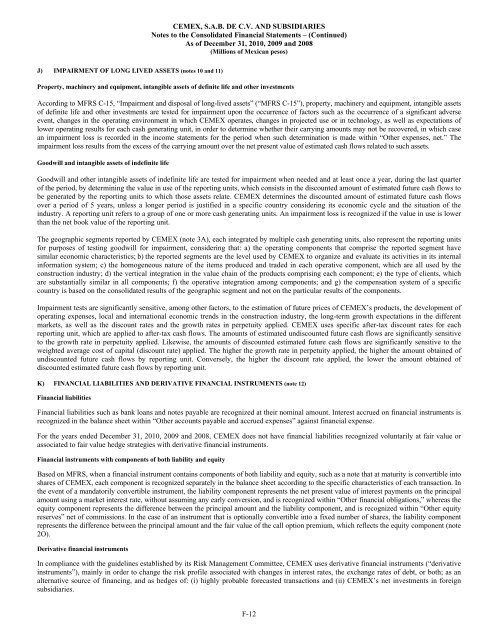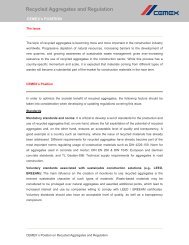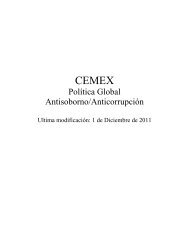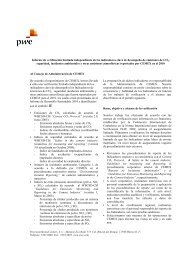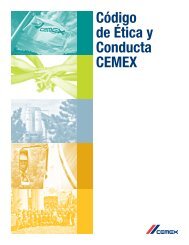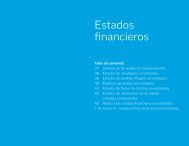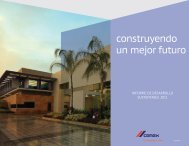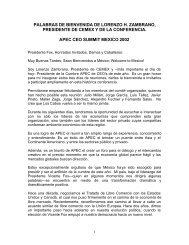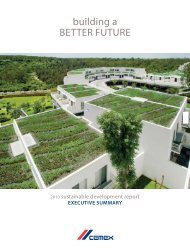building a STRONGER foundation - Cemex
building a STRONGER foundation - Cemex
building a STRONGER foundation - Cemex
Create successful ePaper yourself
Turn your PDF publications into a flip-book with our unique Google optimized e-Paper software.
J) IMPAIRMENT OF LONG LIVED ASSETS (notes 10 and 11)<br />
CEMEX, S.A.B. DE C.V. AND SUBSIDIARIES<br />
Notes to the Consolidated Financial Statements – (Continued)<br />
As of December 31, 2010, 2009 and 2008<br />
(Millions of Mexican pesos)<br />
Property, machinery and equipment, intangible assets of definite life and other investments<br />
According to MFRS C-15, “Impairment and disposal of long-lived assets” (“MFRS C-15”), property, machinery and equipment, intangible assets<br />
of definite life and other investments are tested for impairment upon the occurrence of factors such as the occurrence of a significant adverse<br />
event, changes in the operating environment in which CEMEX operates, changes in projected use or in technology, as well as expectations of<br />
lower operating results for each cash generating unit, in order to determine whether their carrying amounts may not be recovered, in which case<br />
an impairment loss is recorded in the income statements for the period when such determination is made within “Other expenses, net.” The<br />
impairment loss results from the excess of the carrying amount over the net present value of estimated cash flows related to such assets.<br />
Goodwill and intangible assets of indefinite life<br />
Goodwill and other intangible assets of indefinite life are tested for impairment when needed and at least once a year, during the last quarter<br />
of the period, by determining the value in use of the reporting units, which consists in the discounted amount of estimated future cash flows to<br />
be generated by the reporting units to which those assets relate. CEMEX determines the discounted amount of estimated future cash flows<br />
over a period of 5 years, unless a longer period is justified in a specific country considering its economic cycle and the situation of the<br />
industry. A reporting unit refers to a group of one or more cash generating units. An impairment loss is recognized if the value in use is lower<br />
than the net book value of the reporting unit.<br />
The geographic segments reported by CEMEX (note 3A), each integrated by multiple cash generating units, also represent the reporting units<br />
for purposes of testing goodwill for impairment, considering that: a) the operating components that comprise the reported segment have<br />
similar economic characteristics; b) the reported segments are the level used by CEMEX to organize and evaluate its activities in its internal<br />
information system; c) the homogeneous nature of the items produced and traded in each operative component, which are all used by the<br />
construction industry; d) the vertical integration in the value chain of the products comprising each component; e) the type of clients, which<br />
are substantially similar in all components; f) the operative integration among components; and g) the compensation system of a specific<br />
country is based on the consolidated results of the geographic segment and not on the particular results of the components.<br />
Impairment tests are significantly sensitive, among other factors, to the estimation of future prices of CEMEX’s products, the development of<br />
operating expenses, local and international economic trends in the construction industry, the long-term growth expectations in the different<br />
markets, as well as the discount rates and the growth rates in perpetuity applied. CEMEX uses specific after-tax discount rates for each<br />
reporting unit, which are applied to after-tax cash flows. The amounts of estimated undiscounted future cash flows are significantly sensitive<br />
to the growth rate in perpetuity applied. Likewise, the amounts of discounted estimated future cash flows are significantly sensitive to the<br />
weighted average cost of capital (discount rate) applied. The higher the growth rate in perpetuity applied, the higher the amount obtained of<br />
undiscounted future cash flows by reporting unit. Conversely, the higher the discount rate applied, the lower the amount obtained of<br />
discounted estimated future cash flows by reporting unit.<br />
K) FINANCIAL LIABILITIES AND DERIVATIVE FINANCIAL INSTRUMENTS (note 12)<br />
Financial liabilities<br />
Financial liabilities such as bank loans and notes payable are recognized at their nominal amount. Interest accrued on financial instruments is<br />
recognized in the balance sheet within “Other accounts payable and accrued expenses” against financial expense.<br />
For the years ended December 31, 2010, 2009 and 2008, CEMEX does not have financial liabilities recognized voluntarily at fair value or<br />
associated to fair value hedge strategies with derivative financial instruments.<br />
Financial instruments with components of both liability and equity<br />
Based on MFRS, when a financial instrument contains components of both liability and equity, such as a note that at maturity is convertible into<br />
shares of CEMEX, each component is recognized separately in the balance sheet according to the specific characteristics of each transaction. In<br />
the event of a mandatorily convertible instrument, the liability component represents the net present value of interest payments on the principal<br />
amount using a market interest rate, without assuming any early conversion, and is recognized within “Other financial obligations,” whereas the<br />
equity component represents the difference between the principal amount and the liability component, and is recognized within “Other equity<br />
reserves” net of commissions. In the case of an instrument that is optionally convertible into a fixed number of shares, the liability component<br />
represents the difference between the principal amount and the fair value of the call option premium, which reflects the equity component (note<br />
2O).<br />
Derivative financial instruments<br />
In compliance with the guidelines established by its Risk Management Committee, CEMEX uses derivative financial instruments (“derivative<br />
instruments”), mainly in order to change the risk profile associated with changes in interest rates, the exchange rates of debt, or both; as an<br />
alternative source of financing, and as hedges of: (i) highly probable forecasted transactions and (ii) CEMEX’s net investments in foreign<br />
subsidiaries.<br />
F-12


